
How to Shock a Pool
Fiberglass Pool Information | Pool Maintenance | Options and Accessories | Swimming Pool FAQs
A swimming pool is a major investment, not only in financial terms, but also in regards to the amount of time you’ll spend keeping it clean and enjoyable during swim season.
Many homeowners take pool upkeep into their own hands before fully understanding how complex and unpredictable it can sometimes be. This is particularly after big storms, such as Hurricane Ida, which drenched and damaged millions of properties as it tore through a good chunk of the southeastern United States in the late summer of 2021.
But a big storm and an overflowing pool don’t necessarily require pool shock to get back into balance. To keep your pool clean, it’s important to know what to use and when to use it. Pool shock isn’t the solution to all your pool problems, but it can be a key tool in your arsenal against contaminants, cloudiness, and other unwanted pool conditions that might make it harder to swim safely.
But before you use it, you should know...
What is pool shock?
 Pool shock is a product and a process.
Pool shock is a product and a process.
“Shocking” a pool is a pool maintenance process you’ll want to use when its pH level is out of whack.
You’ll typically shock your pool because its “free chlorine” levels are too low to fend off algae and other organic contaminants. This doesn’t mean there’s no chlorine in a pool with low free chlorine.
In fact, your nose may actually tell you when it’s time to shock your pool. A pool with low free chlorine tends to have too much chlorine combined with unwelcome contaminants, which is called chloramine. Chloramine gives off a strong chemical odor of “chlorine,” while you should barely be able to smell free chlorine at all.
Most products marketed as “pool shock” are either more concentrated or simply just reformulated versions of pool chlorine treatments, which are themselves typically more concentrated versions of household bleach.
Some pool shock products are formulated to dissolve faster or be somewhat more effective than standard pool chlorine. However, you can easily see what you’re getting by looking at the labels.
All pool chlorine products, whether marketed as pool shock or something else, must list their active ingredients (and how much of the product is made up of those ingredients) somewhere prominent on their packaging.
These ingredients typically appear right on the front of the box, bag, or bottle. You’ll probably see familiar chemicals like calcium hypochlorite or dichlor (sodium dichloro-s-triazinetrione), which are used to produce everyday pool chlorine, too.
What does pool shock do to a pool?
Pool shock combats built-up chloramine and other contaminants by quickly bringing the “free chlorine” level in your pool water back to its normal range.
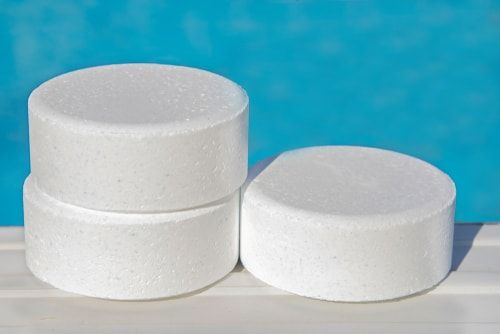
A “normal” range for pool chlorine tends to be between one and three parts per million (1-3 PPM). However, different chlorine manufacturers and pool types may require different concentrations. Make sure you check information provided by your pool builder and the chlorine manufacturer if you’re not sure how much chlorine is “normal” for your pool.
Getting back to this normal range requires more than the normal amount of chlorine.
Pool shock can get your pool water to what’s sometimes called “breakpoint chlorination,” which is the level at which added chlorine will start breaking apart built-up chloramine and other contaminants.
Breaking up chloramine turns it into a gas, which can then evaporate (relatively) harmlessly into the atmosphere, freeing up your pool water for more of the good free chlorine it needs to stay clean.
The ominous terminology used for this process -- “shock” and “breakpoint” and so on -- might give you some indication of how much pool shock you’ll need to get things back to normal. Breakpoint chlorination typically requires adding up to 10 parts of fresh free chlorine for every molecule of chloramine in your pool.
Knowing how much to add will require some basic chemistry.
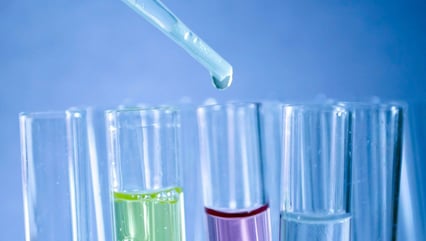
You’ll need to test your pool’s water to determine its chlorine levels, and you should always follow the instructions on your package of pool shock to the letter. If you shock your pool properly, you should be able to get rid of problematic contaminants and wake up to a sparkling, swimmable, super-fun pool.
About the “wake up” part of that statement… you might want to wait till the sun goes down before you add pool shock to the water.
When to shock a pool
Experienced pool pros often recommend shocking your pool at night, after the sun sets.
Why shock your pool at night?
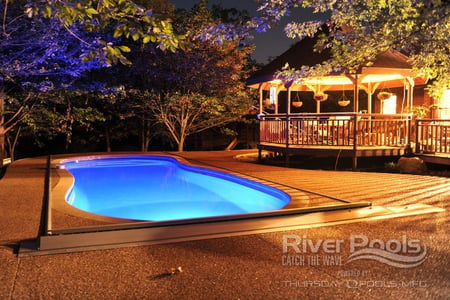
It’s pretty simple.
Chlorine can be neutralized by the sun’s UV rays. If you add pool shock to the water when the sun’s out, you’ll need to add more of it to get the desired effect, because you’ll lose some of it to the sunlight.
It’s also better to add pool shock to your pool at night because there’s less likelihood of unexpected exposure.
You can warn your friends and family, but some folks just won’t realize how risky it can be to jump into a freshly-shocked pool… until they’ve already jumped into it. Save everyone the trouble, and save a little money, by waiting to shock your pool until nighttime.
How often should you shock your pool?
How often do you feel icky when you think about taking a dip in your pool?
How often do you smell chlorine in the backyard?
How often does your pool get inundated by contaminants -- whether it’s from heavy rains, falling debris, careless guests, or anything else unwanted getting in the water?

More importantly… how often does your pool’s free chlorine level drop below its normal range? Are you checking? You should be!
In general, you should shock your pool every one to two weeks during swim season, depending on how often you’ll use your pool, and how heavily trafficked it is.
If you sense any clear warning signs of a pool in need of a good shock, and your test kits tell you the pool is low on free chlorine, it’s probably time for a shock.
You should also shock your pool when you open it in the spring.
No matter how well you’ve prepared your pool, it’s bound to have collected some unwanted gunk and detritus over the winter months. A pre-swim shock before your official opening day should take care of any lingering contaminants.
Salt water and pool shock
If you’ve got a salt chlorinator (a salt water pool system), you might have scrolled all the way down here to figure out if you should even shock your pool at all. You got a salt chlorinator to avoid this sort of messy thing, didn’t you?
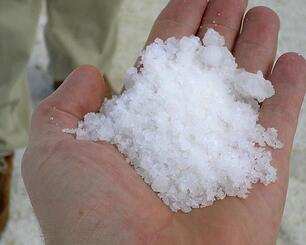
Well, here’s some bad news… you should still shock your salt water pool if its chlorine levels are out of whack, or if it’s become contaminated in any way.
Salt water pools still use chlorine to keep the water clean, and even the best salt chlorinator can become overwhelmed by a major storm or a particularly messy party.
Some salt cells can be set to Shock or Super Chlorinate mode, but this tends to reduce their useful lifespans, and it may not function as a proper pool shock unless your salt chlorinator system is rated for a much larger pool than yours.
Ultimately, the reasons for shocking a saltwater pool are pretty much the same as the reasons for shocking any other kind of pool. The process plays out pretty similarly too, with packaged pool shock going into the water to break up those nasty chloramines and detoxify your pool of its various accumulated gunks.
There are likely to be other steps to the process that are distinct to your salt chlorinator. The salt system’s manual or operating guide should include instructions on how to properly use pool shock with it.
How long after shocking a pool before you can swim?
It depends!
There are different types of pool shock, and they may work in different ways. We’ll review the best types of pool shock below, and the best use cases for each type.
For now, just keep in mind that the most important guideline to “how long should I wait” should be printed somewhere on the shock’s instructions or packaging. Some may get the job done in 15 minutes. Some may take all night.
Either way, it’s better to be patient and safe than it would be to jump in and damage your body. If you’re nervous about side effects, add another 50% more time onto the recommended waiting time on the pool shock’s packaging.
Want to work with a professional who can guide you through every step of pool ownership? Get in touch with us today! We'd be happy to connect you to a top-rated pool care professional in your area, or even help you get things started on your perfect pool project. Just click the button below to contact us for more information:
Is your pool still green after you shock it?
If your pool’s still got gunk in it, you probably didn’t add enough pool shock, which means you didn’t hit the chlorination breakpoint… which, unfortunately, might mean you’ve unintentionally created more chloramines instead of breaking up the existing chloramines.
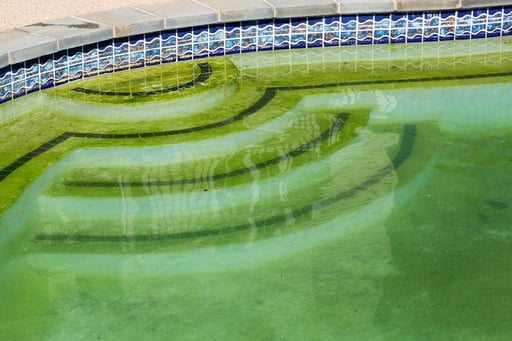
If your pool doesn’t look “normal” after you’ve shocked it, if it smells worse, and particularly if your test kits tell you the pool’s free chlorine levels are still out of whack.
You might have to start over and double-check your tests and your amounts. If problems persist after you’ve tried shocking your pool twice, it might be time to call a pool pro.
Best pool shock
The “best” pool shock isn’t always going to be the best for your pool in every situation.
There are five types of pool shock treatments, most of which are chlorine-based:
Calcium hypochlorite pool shock
Calcium hypochlorite is a popular pool chlorine formulation, and it’s also an effective formulation for pool shock treatments as well.
It’s one of the most expensive pool shock formulations on the market, and it should be widely available, so long as there aren’t supply chain issues (which have been a problem for many products in 2021, including all types of pool chlorine treatments).
Calcium hypochlorite won’t change your pool’s cyanuric acid level -- cyanuric acid, for those unfamiliar with it, is used to extend the lifespan of your pool’s free chlorine. Like chlorine, you’ll want to keep cyanuric acid within a certain concentration in your pool water.

Most chlorine pools do best with 30 to 50 PPM of cyanuric acid. Too little of this chemical can force you to add chlorine more often. Too much cyanuric acid can interfere with free chlorine’s ability to disinfect and clean your pool.
The downside to calcium hypochlorite pool shock treatments is that they can take a while to work, often from eight hours to a full day. This type of pool shock should definitely be added to your pool water at night!
You may also need to prepare dry calcium hypochlorite by mixing it with water before adding it to your pool, which can pose some health risks if you’re not safe. We’ll cover proper use and handling in the next section, because any type of pool shock can be hazardous if handled improperly.
There are a ton of calcium hypochlorite pool shock products available online and in pool supply stores. Here are a few popular and well-reviewed options, most of which are offered in bulk packs for per-unit savings:
- DryTec 1-1901-24 Pool Shock, 1 pound (24-pack)
- HTH 52026 Super Shock, 1 pound (12-pack)
- Rx Clear Super Shock, 1 pound (12-pack)
- HTH 52017 Shock Treatment, 13.3 ounces
Most of the best-selling pool shock products you’ll find will be made with calcium hypochlorite, or with the next type of shock on our list…
Sodium dichlor (dichloro-s-triazinetrione) pool shock
Dichlor is a popular pool chlorine formulation, but it’s a bit less common in pool shock products.
However, it is somewhat more versatile, in that the same dichlor product can generally be used for either everyday pool chlorination or for shocking your pool -- provided you add the right amount for each type of treatment!

Dichlor is a bit easier to use than calcium hypochlorite, since you should be able to add the product directly to your pool without diluting it in water first. It is a longer-acting treatment, so you should give dichlor pool shock treatments at least eight hours to do their job and clean up your pool.
The downside of dichlor, besides its long wait time, is that it can raise the cyanuric acid level in your pool, which might push it above normal ranges and make your pool shock (and your day-to-day chlorine treatments) less effective.
Here are some popular dichlor products, some of which may be branded as everyday pool treatments -- remember, it can do both!
- Rx Clear Stabilized Granular Chlorine, 50 pounds
- In The Swim Granular Pool Shock, 25 pounds
- ProTeam Spa Di Chlor, 2 pounds (6 pack)
Sodium hyopochlorite pool shock
This type of pool shock is more often used in commercial pools. It’s the same formulation as household bleach, which you can use to treat your pool if nothing else is available.
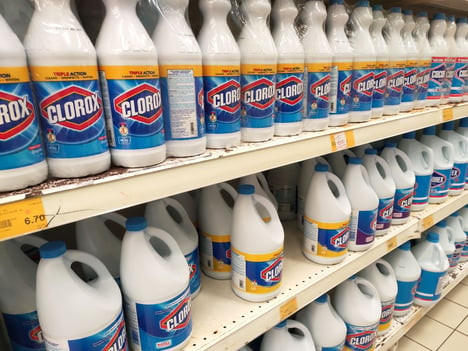
Sodium hypochlorite is typically shipped in large volumes, and in lower concentrations than most other pool shock products. This means it’s already pre-dissolved in liquid form, so you won’t need to mix it before adding it to your pool.
However, you’ll probably need a lot of it to achieve a successful shock, and it may not be the most cost-effective option for a private inground residential pool.
Consider this a backup choice if you can’t find reasonably-priced pool shock products in other formulations. It works, but it’s rarely the most efficient choice.
This 4-pack of one-gallon jugs of 12.5% sodium hypochlorite is a popular product among pool owners, with a 4.5 star rating out of over 500 reviews.
Potassium peroxymonopersulfate (non-chlorine) pool shock
Potassium peroxymonopersulfate pool shock (MPS) is oxygen-based, which means it won’t kill off algae -- it’s not an algaecide. This non-chlorine pool shock is best for pools with too much chloramine, but no evident algae. It’s a good choice for post-party and post-storm shocking, particularly if you want to swim the same day.
MPS is often used in vinyl liner pools, but it’s also popular with pool owners who want their pool clean ASAP. It works quickly, sometimes in just 15 minutes, and it won’t add chlorine to your pool. It also won’t do anything to your pool’s cyanuric acid level.
Most non-chlorine pool shocks are marketed for spas and hot tubs, but they’ll work just fine in the proper quantities. Here are a few good options:
- SpaPure Oxidizing Shock, 5 pounds
- Doheny’s Chlorine Free Oxidizing Shock, 1 pound (12-pack)
- Leisure Time RENU2-04 Renew Hot Tub Shock, 2.2 pounds (4-pack)
Pool shock safety basics
Concentrated chemicals can be dangerous. You should always follow the usage instructions on your pool shock’s packaging.

Your pool pump should be running during the shock process. This helps disperse and spread the shock treatment throughout your pool’s water.
We generally recommend using protective gloves and safety glasses when handling concentrated chlorine of any type or formulation. You may also want to shock your pool while wearing pants, a long-sleeved shirt, and closed-toe shoes, to minimize the possibility of direct exposure to the concentrated chlorine in your pool shock product.
Test your pool water before shocking it! If you don’t already have a high-quality pool water test kit, here are a few popular well-reviewed options:
- WWD POOL Chemical Test Kit
- Poolmaster Water Chemistry Case (Premiere 5-Way Kit)
- Taylor K-2006 Test Kit
The measurements from your tests should tell you how much pool shock to add to the water, based on the manufacturer’s guidelines, and by the current level of free and total chlorine in your water. Once you know how much shock to add, you can either mix it with water or dump it directly into the pool, depending on the manufacturer’s guidelines.
Try to disperse the shock treatment evenly around the pool by walking around the pool perimeter while pouring it out slowly. You should be able to add pool shock around the entire perimeter. Go slow -- it’s better to go around more than once than it would be to drop everything into one corner of the pool.
Once you’ve added all your shock, wait at least as long as the manufacturer recommends before jumping in. If you’ve done everything right, your pool should go right back to its sparkling, swimmable, “normal” state.
Got any questions about pool shock that haven’t been answered here? Please ask us in the comments. We’re happy to help pool owners make the most of their pools!
At River Pools, we manufacture world-class fiberglass pools for customers across North America. If you're shopping around for a fiberglass pool, feel free to take a look at our catalog of models, visit our extensive video library, try out our pool cost calculator, or request custom pricing using the button below.
Editor's Note: This article was originally written by Alex Planes on September 9, 2021. Any opinions expressed are those of the author. Any prices referenced were based on information that was readily available at the time.
River Pools is a brand of inground fiberglass pools produced in a manufacturing facility in Fortville, IN. While our expertise is in manufacturing fiberglass pools, we have access to a network of installers with expertise relating to project design, installation, and pool service. We often tap into this knowledge base and share information freely with homeowners, just like you, considering installing a swimming pool in your backyard.






